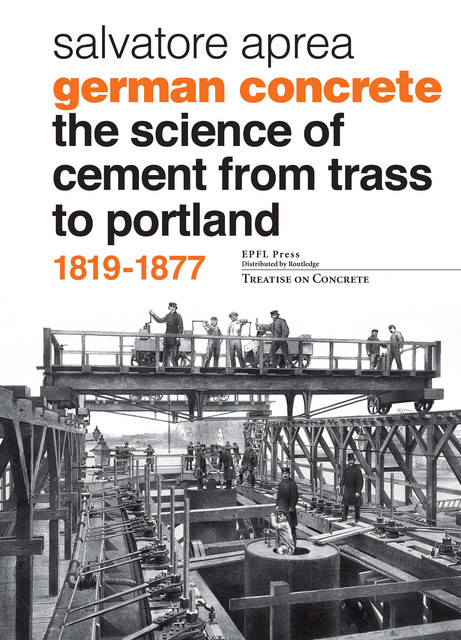Présentation
This book describes for the first time ever, the rise of the modern art of building with concrete in the different German territories stretching from Friesland to Pomerania and southwards from Bavaria to Baden during the first three quarters of the 19th century. Based on careful analyses of historic documents and literature, the book traces an engaging history of master builders, engineers, architects, theoreticians, chemists and inventors tracking the evolution of different building techniques, materials, studies and experiments concerning concrete. It analyses German master builders’ consideration for classical building culture and for contemporaneous constructions observed in neighbouring countries. This narration starts at the turn of the 19th century with early scientific studies on cement, examples of rudimentary concrete used as filling material in small hydraulic foundations and attempts at producing mortar-based artificial stones and moulded objects. The account then follows the progression of cement and the abilities of master builders who worked with concrete until crucial evolutionary stages were reached in the 1870s. Early scientific theories about the chemical reactions in the production and hardening of cement were developed; concrete was finally used to build huge underwater foundations as well as entire houses; the production of mortar-based artificial stones and moulded objects became a significant manufacturing branch; the first standards for the production and sale of Portland cement were defined and officially implemented.
Sommaire
- Lime, trass, mortar, concrete and artificial stones at the turn of the 19th century: Premises for the development of concrete – The state-of-the-art knowledge about lime, between alchemical heritage and scientific achievements – Cement, the practices of producing hydraulic mortar and the importance of trass – Rudimental traces of concrete in foundations, between local experiments and references to antiquity – Hollow masonry-faced walls filled with concrete – French concrete foundations in Rhineland – The ambition to produce mortar-based artificial stone
- New knowledge about hydraulic lime, cement and mortar: The Theorie des besten Mörtels by John – A new awareness about hydraulic lime and mortar – Cement from England and policies for the Gewerbeförderung – Artificial stones by Sachs and moulded statues by De la Rivallière-Preignac von Frauendorf – Roman cement applications and hydraulic lime manufacturing – Concrete hydraulic foundations: trass versus – hydraulic lime – The realization of John’s theory in Fuch’s studies – on lime and mortar – Concrete foundations in technical literature
- Hydraulic lime and cement manufacturing: The Bavarian hydraulic lime, a mineralischer Schatz – Cement manufacturing in Northwest and central Germany, from Hamburg to Kassel – Further production of hydraulic lime and the persistent fascination with English Roman cement in Prussia – Mortar, plaster and concrete, experimental uses of Kassel and Hamelin cement, and the attempts to build continuous masonry elements
- Concrete foundations, walls, artificial stones: Concrete foundations in regions along the Rhine, the persisting use of trass – Concrete foundations in Bavaria and Pomerania, the exploitation of local hydraulic lime – Lean conglomerates for rural buildings and the development of Kalksand – Concrete and cement in Hamburg, between Dutch, French and English influences – Moulded cement-based artificial stones and mortar tiles – Concrete fillings for bridge decks, and to restore masonry cracks – The concrete foundations of the piers for the railway bridges in Dirschau and Marienburg, the development of local artificial cement by Lentze – Further studies about materials used to produce hydraulic mortar and concrete
- Portland cement and concrete construction, from foundations to roofs: Portland cement and its prevalent use in binding brickwork – The manufacturing of Portland cement by Bleibtreu – The acknowledgment of the monolithic behaviour – of concrete and the further spread of concrete foundations – Lean conglomerate as a German kind of concrete – for above-ground constructions – The manufacturing of Cementwaaren – Improvements to scaffoldings and sheet pilings – for foundations underwater, the building of the bridge over the Rhine in Koblenz – Sinking wells, sinking caissons and pneumatic caissons – Concrete for above-ground constructions – Further studies about Portland cement and the regulation of its main physical features
Informations
Editeur : EPFL Press English Imprint
Collection : Treatise on Concrete
Publication : 1 août 2016
Edition : 1ère édition
Support(s) : Livre papier
Nombre de pages Livre papier : 256
Format (en mm) Livre papier : 170 x 240
Poids (en grammes) : 790
Langue(s) : Anglais
EAN13 Livre papier : 9782940222964
Du même auteur
Concrete in Switzerland Histories from the Recent Past
Salvatore Aprea, Nicola Navone, Laurent Stalder, Sarah Nichols
39,81 €
Dans la même collection
The Rhetoric of Pier Luigi Nervi Concrete and Ferrocement Forms
Roberto Gargiani, Alberto Bologna
113,74 €
Concrete, from archeology to invention 1700-1769 The Renaissance of Pozzolana and Roman Construction Techniques
109,00 €
Ils ont aussi acheté
Concrete in Switzerland Histories from the Recent Past
Salvatore Aprea, Nicola Navone, Laurent Stalder, Sarah Nichols
39,81 €
Electronique Vol. 1: Amplificateur opérationnel et applications
34,15 €
Les dispositifs du confort dans l'architecture du XXe siècle:connaissance et stratégie de sauvegarde Building Environment and Interior Comfort in 20th-Century Architecture: Understanding Issues and Developing Conservation Strategies
56,00 €
The Rhetoric of Pier Luigi Nervi Concrete and Ferrocement Forms
Roberto Gargiani, Alberto Bologna
113,74 €
Sur des thèmes similaires
New Brutalism The invention of a style
52,15 €
Interoperability An introduction to IFC and buildingSmart standards integrating infrastructure modeling
Bernd Domer, Rachele Bernardello
42,65 €
Unearthing traces Dismantling imperialist entanglements of archives, landscapes, and the built environment
À partir de 0,00 € (gratuit)
Studies on types Dormitories
À partir de 0,00 € (gratuit)






